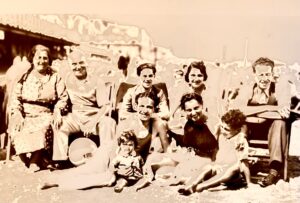The Meaning of End-of-Life Visions
by
Tracy Shawn, M.A.

Ancestors by Tracy Shawn
Hospice workers across the world note that deathbed visions are a common occurrence. Loved ones and friends are often in awe when the dying share that they’re being visited by long-lost relatives, religious figures, and even beloved pets, who have long since passed. Scientists theorize that these visions could be the brain’s own self-induced opiate to ease the fear and pain of dying. Perhaps various meds, as well, may produce these seemingly hallucinatory states.
Research on Deathbed Visions
However, many people—including a number of hospice workers—believe that these visions are real. An article titled “What Do We Know About Deathbed Visions?” by Stephen Wagner for Liveabout.com, notes one of the first scientific studies of this phenomena was by Sir William Barrett, a Professor of Physics at the Royal College of Science in Dublin during the 1920s. Barrett came up with some fascinating results. One of the most perplexing was that many of these visions involved people who the dying person thought were still alive—yet (as it was later discovered) had actually passed on.
Later studies also corroborate that sometimes the dying person did not know that their “visitors” were already dead. The question, then, is why would the dying brain only create visions of people who had already died—whether the person knew they were dead or not?
Wagner also talks about how these spirit visitors are sometimes seen not just by the dying, but also by relatives and friends who are gathered around the patient. A case documented in the Journal of the Society for Psychic Research notes that a dying woman—and her three relatives—all saw the same apparition.
When researching this further, I came across a blog piece from a hospice site (crossroadshospice.com) that matter-of-factly states: “These visions are not hallucinations or a reaction to medication.” In my own personal experience, the hospice caretakers who so tenderly helped care for my mom in her last days were also very clear that it wasn’t at all unusual for her to be visited by relatives who had passed on. These very same caretakers also explained that these spirits come to help the dying pass over to the other side, as well as help them let go of their present life.
How End-of-Life Visions Help the Dying—and the Living
Although my mother experienced horrible side effects from her pain medicine, including severe hallucinations in the months leading up to her death, there was an otherworldly moment that I’ll never forget. About four days before she died, she turned her gaze toward the top of her bookshelf. I wondered if she might be looking at an old photo of her glamorous self—but even at that time I noticed that it seemed so much poignant than that. A sense of peace enveloped the whole room, and her eyes widened with utter wonderment as a beatific smile crossed her lips—the very same description that I’ve since read over and over again about what dying patients look like when they are seeing long lost relatives and friends. Of course, I don’t know whether this was a truly spectral experience—or my own grieving brain hoping that my mother found some peace toward the end, and, wishing as well, that we’d somehow see each other again.
Final Thoughts
Perhaps we will never know for sure whether end of life visions are real or not—that is until we ourselves pass from this life. Regardless, researchers and caretakers alike agree that these visions provide a sense of peace, bringing healing and comfort to both the dying and the living.
Tracy Shawn lives and writes on the Central Coast of California with her husband, two mischievous cats, and loyal pit bull. Her debut novel, The Grace of Crows, won several indie book awards. Tracy Shawn’s short stories have appeared in Literary Brushstrokes, Psychology Tomorrow Magazine, and Steel House Review Literary Journal. She’s written numerous articles for print and online publications, and is excited to announce that her second novel will be released in summer of 2021.
